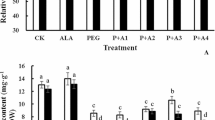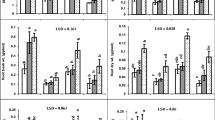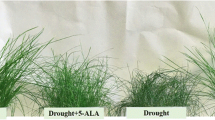Abstract
This study evaluates the role of exogenous foliar application of 5-aminolevulinic acid (ALA) on water relations, gas exchange, chlorophyll fluorescence, and the activities and gene expression patterns of antioxidant enzymes in leaves of oilseed rape under drought stress and recovery conditions. Seedlings at four-leaf stage were imposed to well-watered condition (80 % of water-holding capacity) or drought stress (40 % of water-holding capacity) and subsequently foliar sprayed with water or ALA (30 mg l−1). Drought suppressed the accumulation of plant biomass and decreased chlorophyll content and leaf water status (relative water content and water potential). The actual quantum yield of photosystem II and electron transport rates were hampered in parallel to net photosynthetic rate. However, drought stress induced the accumulation of malondialdehyde (MDA) and hydrogen peroxide, enhanced the activities of catalase (CAT), peroxidase (POD), ascorbate peroxidase (APX), glutathione reductase (GR) and superoxide dismutase and up-regulated the expression of APX and GR. After rehydration for 4 days, the growth of drought-treated seedlings was restored to normal level for most of the physiological parameters. Foliar application of ALA maintained relatively higher leaf water status and enhanced chlorophyll content, net photosynthetic rate, actual quantum yield of photosystem II, photochemical quenching, non-photochemical quenching and electron transport rates in stressed leaves. Exogenous ALA also alleviated the accumulation of MDA and hydrogen peroxide, increased the activities of antioxidant enzymes and enhanced the expression of CAT and POD in drought-treated plants. These results indicate that ALA may effectively protect rapeseed seedlings from damage induced by drought stress.








Similar content being viewed by others
References
Apel K, Hirt H (2004) Reactive oxygen species: metabolism, oxidative stress, and signal transduction. Annu Rev Plant Biol 55:373–399
Arnon DI, Hoagland DR (1940) Crop production in artificial culture solutions and in soils with special reference to factors influencing yields and absorption of inorganic nutrients. Soil Sci 50:463–485
Bian S, Jiang Y (2009) Reactive oxygen species, antioxidant enzyme activities and gene expression patterns in leaves and roots of Kentucky bluegrass in response to drought stress and recovery. Sci Hortic (Amsterdam) 120:264–270
Bradford MM (1976) Rapid and sensitive method for quantitation of microgram quantities of protein utilizing principle of protein–dye binding. Anal Biochem 72:248–254
Castelfranco PA, Jones OTG (1975) Protoheme turnover and chlorophyll synthesis in barley tissue. Plant Physiol 55:485−490
Chakrabory N, Tripathy BC (1992) Involvement of singlet oxygen in 5-aminolevulinic acid induced photodynamic damage of cucumber chloroplast. Plant Physiol 98:7–11
Craven D, Gulamhussein S, Berlyn GP (2010) Physiological and anatomical responses of Acacia koa (Gray) seedlings to varying light and drought conditions. Environ Exp Bot 69:205–213
Dai QL, Chen C, Feng B, Liu TT, Tian X, Gong YY, Sun YK, Wang J, Du SZ (2009) Effects of different NaCl concentration on the antioxidant enzymes in oilseed rape (Brassica napus L.) seedlings. Plant Growth Regul 59:273–278
FAOSTAT, Food and Agriculture Organization of the United Nations (2011). http://faostat.fao.org/site/339/default.aspx
Farooq M, Wahid A, Kobayashi N, Fujita D, Basra SMA (2009) Plant drought stress: effects, mechanisms and management. Agron Sustain Dev 29:185–212
Farooq M, Wahid A, Lee DJ, Cheema SA, Aziz T (2010) Comparative time course action of the foliar applied glycinebetaine, salicylic acid, nitrous oxide, brassinosteroids and spermine in improving drought resistance of rice. J Agron Crop Sci 196:336–345
Flexas J, Ribas-Carbo M, Diaz-Espejo A, Galmes J, Medrano H (2008) Mesophyll conductance to CO2: current knowledge and future prospects. Plant Cell Environ 31:602–621
Genty B, Briantais JM, Baker NR (1989) The relationship between the quantum yield of photosynthetic electron-transport and quenching of chlorophyll fluorescence. Biochim Biophys Acta 990:87–92
Gong HJ, Chen KM, Zhao ZG, Chen GC, Zhou WJ (2008) Effects of silicon on defense of wheat against oxidative stress under drought at different developmental stages. Biol Plantarum 52:592–596
Härtel H, Haseloff RF, Walter G, Rank B (1993) Photoinduced damage in leaf segments of wheat (Triticum aestivum L.) and lettuce (Lactuca sativa L.) treated with 5-aminolevulinic acid II. Characterization of photodynamic damage by means of delayed chlorophyll fluorescence and P700 photooxidation. J Plant Physiol 142:237–243
Härtel H, Lokstein H, Grimm B, Rank B (1996a) Kinetic studies on the xanthophylls cycle in barley leaves. Plant Physiol 110:471–482
Härtel H, Walter G, Haseloff RF, Hoffmann P, Renger G (1996b) Photochemical and non-photochemical energy dissipation in response to 5-aminolaevulinic acid-induced photosensitization of green leaves of wheat (Triticum aestivum L.) and lettuce (Lactuca sativa L.). J Photochem Photobiol B Biol 32:115–126
Hotta Y, Tanaka T, Takaoka H, Takeuchi Y, Konnai M (1997) Promotive effects of 5-aminolevulinic acid on the yield of several crops. Plant Growth Regul 22:109–114
Jiang MY, Zhang JH (2002) Water stress-induced abscisic acid accumulation triggers the increased generation of reactive oxygen species and up-regulates the activities of antioxidant enzymes in maize leaves. J Exp Bot 53:2401–2410
Jin ZL, Zhang F, Ahmed ZI, Rasheed M, Naeem MS, Ye QF, Zhou WJ (2010) Differential morphological and physiological responses of two oilseed Brassica species to a new herbicide ZJ0273 used in rapeseed fields. Pestic Biochem Phys 98:1–8
Jin ZL, Tian T, Naeem MS, Jilani G, Zhang F, Zhou WJ (2011) Chlorophyll fluorescence responses to application of new herbicide ZJ0273 in winter oilseed rape species. Int J Agric Biol 13:43–50
Jones MM, Turner NC (1978) Osmotic adjustment in leaves of sorghum in response to water deficits. Plant Physiol 61:122–126
Korkmaz A, Korkmaz Y, Demirkiran AR (2010) Enhancing chilling stress tolerance of pepper seedlings by exogenous application of 5-aminolevulinic acid. Environ Exp Bot 67:495–501
Li FL, Wu XZ, Tsang E, Cutler AJ (2005) Transcriptional profiling of imbibed Brassica napus seed. Genomics 86:718–730
Liu D, Pei ZF, Naeem MS, Ming DF, Liu HB, Khan F, Zhou WJ (2011) 5-Aminolevulinic acid activates antioxidative defence system and seedling growth in Brassica napus L. under water-deficit stress. J Agron Crop Sci 197:284–295
Livak KJ, Schmittgen TD (2001) Analysis of relative gene expression data using real-time quantitative PCR and the 2−ΔΔCT method. Methods 25:402–408
Loggini B, Scartazza A, Brugnoli E, Navari-Izzo F (1999) Antioxidative defense system, pigment composition, and photosynthetic efficiency in two wheat cultivars. Plant Physiol 119:1091–1099
Lokstein H, Härtel H, Hoffmann P (1993) Comparison of chlorophyll fluorescence quenching in leaves of wild-type with a chlorophyll-b-less mutant of barley (Hordeum vulgare L.). J Photochem Photobiol B Biol 19:217–225
Maxwell K, Johnson GN (2000) Chlorophyll fluorescence—a practical guide. J Exp Bot 51:659–668
Memon SA, Hou XL, Wang LJ, Li Y (2009) Promotive effect of 5-aminolevulinic acid on chlorophyll, antioxidative enzymes and photosynthesis of Pakchoi (Brassica campestris ssp. chinensis var. communis Tsen et Lee). Acta Physiol Plant 31:51–57
Mittler R, Zilinskas BA (1994) Regulation of pea cytosolic ascorbate peroxidase and other antioxidant enzymes during the progression of drought stress and following recovery from drought. Plant J 5:397–405
Moller IM, Jensen PE, Hansson A (2007) Oxidative modifications to cellular components in plants. Annu Rev Plant Biol 58:459–481
Müller T, Luttschwager D, Lentzsch P (2010) Recovery from drought stress at the shooting stage in oilseed rape (Brassica napus). J Agron Crop Sci 196:81–89
Naeem MS, Jin ZL, Wan GL, Liu D, Liu HB, Yoneyama K, Zhou WJ (2010) 5-Aminolevulinic acid improves photosynthetic gas exchange capacity and ion uptake under salinity stress in oilseed rape (Brassica napus L.). Plant Soil 332:405–415
Naeem MS, Rasheed M, Liu D, Jin ZL, Ming DF, Yoneyama K, Takeuchi Y, Zhou WJ (2011) 5-Aminolevulinic acid ameliorates salinity-induced metabolic, water-related and biochemical changes in Brassica napus L. Acta Physiol Plant 33:517–528
Neumann PM (2008) Coping mechanisms for crop plants in drought-prone environments. Ann Bot (London) 101:901–907
Nishihara E, Takahashi K, Nakata N, Tanaka K, Watanabe K (2001) Effect of 5-aminolevulinic acid (ALA) on photosynthetic rate, hydrogen peroxide content, antioxidant level and active oxygen-scavenging enzymes in spinach (Spinacia oleracea L.). J Jpn Soc Hortic Sci 70:346–352
Nishihara E, Kondo K, Parvez MM, Takahashi K, Watanabe K, Tanaka K (2003) Role of 5-aminolevulinic acid (ALA) on active oxygen-scavenging system in NaCl-treated spinach (Spinacia oleracea). J Plant Physiol 160:1085–1091
Oxborough K, Baker NR (1997) Resolving chlorophyll a fluorescence images of photosynthetic efficiency into photochemical and non-photochemical components—calculation of qP and F v ′/F m ′ without measuring Fo ′. Photosynth Res 54:135–142
Porra RJ, Thompson WA, Kriedemann PE (1989) Determination of accurate extinction coefficients and simultaneous-equations for assaying chlorophyll a and chlorophyll b extracted with 4 different solvents: verification of the concentration of chlorophyll standards by atomic-absorption spectroscopy. Biochim Biophys Acta 975:384–394
Ralph PJ, Gademann R (2005) Rapid light curves: a powerful tool to assess photosynthetic activity. Aquat Bot 82:222–237
Rebeiz CA, Montazer-Zouhoor A, Hopen H, Wu SM (1984) Photodynamic herbicides. I. Concept and phenomenology. Enzyme Microb Technol 6:390–396
Sun YP, Zhang ZP, Wang LJ (2009) Promotion of 5-aminolevulinic acid treatment on leaf photosynthesis is related with increase of antioxidant enzyme activity in watermelon seedlings grown under shade condition. Photosynthetica 47:347–354
van Kooten O, Snel JFH (1990) The use of chlorophyll fluorescence nomenclature in plant stress physiology. Photosynth Res 25:147–150
Wang, L, Liu W, Sun G, Wang J, Jiang W, Liu H, Li Z, Zhuang M (2005) Effects of 5-aminolevulinic acid on photosynthesis and chlorophyll fluorescence of radish seedlings. Acta Bot Boreal Occident Sin 25:488–496
Wang LJ, Jiang WB, Huang BJ (2004) Promotion of 5-aminolevulinic acid on photosynthesis of melon (Cucumis melo) seedlings under low light and chilling stress conditions. Physiol Plantarum 121:258–264
White AJ, Critchley C (1999) Rapid light curves: a new fluorescence method to assess the state of the photosynthetic apparatus. Photosynth Res 59:63–72
Woo, NS, Badger MR, Pogson BJ (2008) A rapid, non-invasive procedure for quantitative assessment of drought survival using chlorophyll fluorescence. Plant Methods 4:27
Youssef T, Awad MA (2008) Mechanisms of enhancing photosynthetic gas exchange in date palm seedlings (Phoenix dactylifera L.) under salinity stress by a 5-aminolevulinic acid-based fertilizer. J Plant Growth Regul 27:1–9
Zhang WF, Zhang F, Raziuddin R, Gong HJ, Yang ZM, Lu L, Ye QF, Zhou WJ (2008) Effects of 5-aminolevulinic acid on oilseed rape seedling growth under herbicide toxicity stress. J Plant Growth Regul 27:159–169
Zhou W, Zhao D, Lin X (1997) Effects of waterlogging on nitrogen accumulation and alleviation of waterlogging damage by application of nitrogen fertilizer and mixtalol in winter rape (Brassica napus L.). J Plant Growth Regul 16:47–53
Acknowledgments
This work was supported by the Special Fund for Agro-scientific Research in the Public Interest (201303022), the National Key Science and Technology Supporting Program of China (2010BAD01B01), the National Natural Science Foundation of China (31000678, 31071698) and the Science and Technology Department of Zhejiang Province (2012C12902-1, 2011R50026-5).
Author information
Authors and Affiliations
Corresponding author
Additional information
Communicated by U. Feller.
Rights and permissions
About this article
Cite this article
Liu, D., Wu, L., Naeem, M.S. et al. 5-Aminolevulinic acid enhances photosynthetic gas exchange, chlorophyll fluorescence and antioxidant system in oilseed rape under drought stress. Acta Physiol Plant 35, 2747–2759 (2013). https://doi.org/10.1007/s11738-013-1307-9
Received:
Revised:
Accepted:
Published:
Issue Date:
DOI: https://doi.org/10.1007/s11738-013-1307-9




